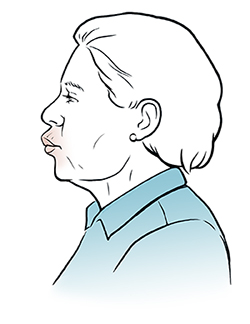Dysphagia: Exercises
Dysphagia is a swallowing problem that makes eating and drinking harder to do. It can be described as difficulty getting food from the mouth to the stomach safely. Choking and loss of food may be more likely when you have this disorder. This often happens due to a lack of control over food or liquid, or a secondary weakness in the face muscles or the tongue. Swallowing wrong may cause food or liquid to enter your lungs. This can put you at risk for pneumonia. With the direction of a licensed speech-language pathologist (SLP), the exercises below may help. They are done to strengthen and increase movement in the face and mouth muscles. This can make eating food safer and easier. An SLP plays a key role in diagnosing and developing treatment for people with swallowing problems.
Increase lip control
 |
| Exercises are done to help you control your lips. |
By improving how well your lips close, you can reduce drooling. You may also have less food collect between your gums and cheeks. Practice these exercises ______ times a day.
-
Pucker your lips. Kiss the air, then relax. Do _____ times.
-
Blow and suck through a drinking straw. Do _____ times.
-
Close your mouth and puff out your cheeks. Do _____ times.
-
Smile _____ times.
Increase tongue strength
 |
| Exercises are done to help you strengthen your tongue. |
These exercises can help make your tongue stronger and better able to move. Practice them ______ times a day.
-
Stick your tongue out as far as you can. Do _____ times.
-
Bring the tip of your tongue toward your nose. Do _____ times.
-
Stretch your tongue toward your chin. Do _____ times.
-
Touch the corners of your mouth with the tip of your tongue. Go back and forth _____ times.
-
Push your tongue against the inside of each of your cheeks. Do _____ times.
Online Medical Reviewer:
Melinda Murray Ratini DO
Online Medical Reviewer:
Raymond Kent Turley BSN MSN RN
Online Medical Reviewer:
Sumana Jothi MD
Date Last Reviewed:
12/1/2022
© 2000-2025 The StayWell Company, LLC. All rights reserved. This information is not intended as a substitute for professional medical care. Always follow your healthcare professional's instructions.